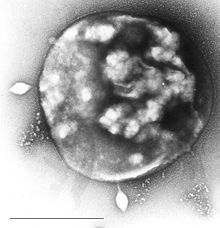
Back Sulfolobus AN سلفولوبس ARZ Sulfolobus Czech Sulfolobus German Sulfolobus Spanish Sulfolobus Basque Sulfolobus French Sulfolobus Galician Sulfolobus Hungarian Sulfolobus ID
| Sulfolobus | |
|---|---|

| |
| Electron micrograph of Sulfolobus infected with Sulfolobus virus STSV1. Bar = 1 μm. | |
| Scientific classification | |
| Domain: | Archaea |
| Kingdom: | Proteoarchaeota |
| Superphylum: | TACK group |
| Phylum: | Thermoproteota |
| Class: | Thermoprotei |
| Order: | Sulfolobales |
| Family: | Sulfolobaceae |
| Genus: | Sulfolobus Brock, Brock, Belly & Weiss 1972 |
| Type species | |
| Sulfolobus acidocaldarius Brock et al. 1972
| |
| Species | |
| |
Sulfolobus is a genus of microorganism in the family Sulfolobaceae. It belongs to the archaea domain.[2]
Sulfolobus species grow in volcanic springs with optimal growth occurring at pH 2–3 and temperatures of 75–80 °C, making them acidophiles and thermophiles respectively. Sulfolobus cells are irregularly shaped and flagellar.
Species of Sulfolobus are generally named after the location from which they were first isolated, e.g. Sulfolobus solfataricus was first isolated in the Solfatara volcano. Other species can be found throughout the world in areas of volcanic or geothermal activity, such as geological formations called mud pots, which are also known as solfatare (plural of solfatara).
- ^ Dai, X; Wang, H; Zhang, Z; Li, K; Zhang, X; Mora-López, M; Jiang, C; Liu, C; Wang, L; Zhu, Y; Hernández-Ascencio, W; Dong, Z; Huang, L (2016). "Genome Sequencing of Sulfolobus sp. A20 from Costa Rica and Comparative Analyses of the Putative Pathways of Carbon, Nitrogen, and Sulfur Metabolism in Various Sulfolobus Strains". Frontiers in Microbiology. 7: 1902. doi:10.3389/fmicb.2016.01902. PMC 5127849. PMID 27965637.
- ^ See the NCBI webpage on Sulfolobus. Data extracted from the "NCBI taxonomy resources". National Center for Biotechnology Information. Retrieved 2007-03-19.